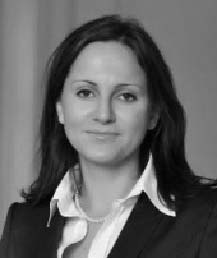Aleksandar Žjak - Residential and comercial skyscraper in block 43
Published in: Journal of the Faculty of Technical Sciences, Novi Sad
Candidate:

Aleksandar Žjak, born in Belgrade in 1989. After graduating from technical school in Pancevo 2008th enrolled study architecture at the University 'Union - Nikola Tesla "in Belgrade. In september 2012. gained a degree in Architectural Engineering. That same year he enrolled Master studies at the Faculty of Technical Sciences in Novi Sad.
Mentor:

Dr Jelena Atanacković Jeličić, was born in 1977. She received her Ph.D. 2007. in Faculty of Technical Sciences in Novi Sad. The members of the City Council was appointed by the City of Novi Sad.
Abstract – The aim of the project is to develop, organize and design a luxury residential and commercial catering complex with at least 15 floors, which will be in one place to provide a high quality business and especially housing. The building contains three types of apartments and 34 of them. Each apartment has a large terrace with a garden and environmental units, wich create each jousing unit and articulate eco-urban dimension of housing. In Block 43, will be four such facilities, with appropriate capacity of the immanent to the parking on the ground floor. Above the parking area there is park, an urban strucutre, which is intended for passive recreation, and relaxation and entertainment tenants, as well as all other citizens. Specifically, in Belgrade, the construction of skyscrapers is a rare case. There are several facilities like "Beograđanka" and "The Gates of Belgrade", which were built at the time when the country was economically strong. There are plans to build over 19 skyscrapers over the next few years, after which the city will be leading the construction in this part of Europe.
1. INTRODUCTION
Housing as a form of existence is the essence of human beings and even represents a state of mind. Martin Heidegger directly associated feeling of serenity and life, connecting the home to the invention of peace. The place where living, to a greater or lesser extent, is the space in which we are free to organize their own lives in a way that suits us.
In contrast to Le Corbusier defining housing as a dormitory for "storage" of the working class, housing is more than just accommodation users. It has its own spatial and temporal identity, and is one of the main problems of mankind. Housing involves various forms of everyday basic needs of people and a wide range of aspects of life.
Housing should be seen as a process consisting of programming, planning, design, construction - all the way to the use of the apartment, where the apartment is only one element of the process. Determine the future conception of residence is possible only through an interdisciplinary approach. The answer to the question of the concept of apartment and housing, can be given only through the compilation and systematization of experiences of all the factors that participate in housing construction. Likewise, the issue of improving the quality of the apartment and housing, can be viewed, accentuate, and dealt with, only the positions of the acquired theoretical knowledge and practical knowledge of overall experience in the complex process of planning.
2. RESIDENTIAL PURPOSES
It turned out that the most correct and most fruitful approach to the conceptualization of living space, which arises directly from human needs. The building housing should come from human needs, theoretically they clarify and elaborate, and architectural design and construction practices directed according to compliance. Every act of architectural materialization of housing should be based on explicit attitudes toward satisfying specific needs, which the space is intended to serve.
So, it is not enough just to build condos. In order for that to be successful, we must first start control and analysis of your own apartment to human and psychological components of the problem and its varying aspects. Of course, this is the best starting point if you want to achieve high standards of achievement and articulation of the concept of modern flats and housing.
Housing needs and the extent to which those needs are met, are one of the criteria for determining the use value of the apartment. The value of the building (apartment) does not arise out of the building, but in life as well as those activities that it provides a framework and the necessary requirements in terms of facilities and techniques.
The diversity of housing needs of users arises from the nature of the variability of residence. This is variability of double origin. On the one hand, it happens that the action of external influences on the housing act of a wider framework - space, time, social - social and cultural dimensions, and on the other hand, the variability is going on under the influence of changes in the family itself - the number of members, the age structure and economic opportunities, lifestyle, etc.. All of these variables are reflected in many apartment customer requirements that are different nature.
3. PERMANENT AND VARIABLE IN HOUSING
The living area should always be adapted to human needs, not user adapted space. Only a flexible and dynamic living space, it is possible to adjust the daily and the dynamic needs of the user.
It usually happens that the "physical frame" is not sufficiently "flexible". As such, often does not meet the complexity and dynamics of human needs, activities and opportunities. In this way, it seems that the "physical frame" is not intended (designed) to "react" to their dynamics, diversity and change. Omnipresent is the development - flexibility and openness to change.
Today's flat in collective housing construction defined "static structure," and at best allow only minimal structural changes, or make minor adaptations according to the user's request.
Precisely in this regard, "dynamic" and "static" categories that appear in the whole process of creation and use of an apartment, visible and fundamental problems, but also a possible route to solving the problem of housing.
The most important measure of the quality of the apartment is the satisfaction of its users. Flexibility and adaptation are the real requirements that directly enable the level of customer satisfaction. This confirms that the flexibility of the apartment in time with various and changing requirements (user), is one of the most important criteria of quality apartments and housing. Therefore, the flexibility is very much an important basis for the concept of the modern formulation of the apartment.
4. BASIC IDEA AND CONCEPT
The idea is that the complex consists of four freestanding towers, which are located in close distance to each other and are associated parking and landscaping a park stylized microambients. In this way a group format and sustainable landscape-architectural-urban area with sustainable ecoreciprocity between high, low and landscape built physical structures.
Multilateral accession block is provided with several approaches. Within blocks around the buildings, provided the optimal dimensioned parking and parking space that connects the two towers on one side and on the other side. Above the parking area, there is a garden and a park styled microambients for passive recreation and relaxation and recreation of residents and other users.
The concept of the skyscraper is the a box for living (Figure 1). The big box is divided into a total of 18 levels. Each level or floor is structurally determined that boxes stacked one on the other takes a final look. Large terraces, which will serve as a garden and ambient units, will be one aspect of a garden to micro-ennobled for residents who have more developed eco-awareness and needs for eco-housing. This is particularly important in terms of expressed environmental changes for which already suffer local urban community. On each floor there are two housing units that are more intimate character. Each unit will have its own elevator and the possibility of direct entry into the apartment of the same.

Figure 1. The concept of a skyscraper
5. LOCATION AND URBAN CONTEXT
Location of residential and business complex is Block 43 in New Belgrade, Bulevar Milutin Milankovic (Figure 2). This favorable location gives residents an advantage, because it is well organized and developed transport infrastructure and the public highway system. This building land is currently undeveloped, so there is no need for the removal of any object, but only its landscape and architectural and urban transformation in the context of sustainable ecoreciprocity between projected high, low and landscape built buildings, units or artifacts.
Further characterized by the location and proximity to shopping centers, "Ušće" and "Delta City ', as well as good connections to other parts of the city. Motor vehicles and pedestrians is possible from the Boulevard "Milutin Milanković" and "Antifašističke borbe" street.

Figure 2. Location of planned residential and commercial building
6. SPACE-PROGRAM CONCEPT FACILITY
The building is designed as a residential and office towers, where the spatial distribution is taken into consideration, to make it as good as possible defining content, floors, as well as the capacity of garden and park structures and parking lots (Figure 3).

Figure 3. Residential and commercial complex
6.1. The functionality of the object
According to the purpose the building was designed as a residential building with shops on the ground floor and first floor. Total number of floors of the building is ground floor and 17 more floors.
Parking of vehicles is provided on a prepared parking area around the newly designed tower and a portion of the closed park, which will be used exclusively for the residents of these facilities. Vehicular access to the complex is controlled and provided for parking capacity allows each apartment has a minimum of two parking spaces.
On the ground floor elevation provided the main access to the building, the main staircase, technical facilities and premises for rent. Main staircase zone is protected and separated from the hallway bezebednosnih reasons. The entrance to the building is controlled by a security guard or a receptionist, who have their own space at the main entrance.
On the upper floors are intended for residential areas of high standards of construction and equipment. There is projected three different types of floors that differ by squaring the home (interior space) and a terrace garden and a refined ambience of the unit. Floors are arranged so that each unit reaches a sufficient amount of light. The residential units are designed with a high level of flexibility and enables a variety of functionality changes within the unit.
6.2. Furnishing and landscaping
The finish of the walls is in the form of panels which are hanging in the steel skeleton. These are multi-layer sandwich panels that are performed in accordance with the rules set regulations on energy efficiency.
Interior landscaping is reduced to processing and materials of high standards. There are also represented sandwich panels that serve as walls, and they have very good quality and sound insulating properties.
6.3. Appliances, lighting and maintenance
Rooms designed for maintenance works are planned in the area of the ground floor. From technical infrastructure elements in the objects are present in water meters, electric meters, substations, vertical communication.
The lighting in all rooms is provided as a combination of the natural and the artificial, with the artificial is used only at night. The aim is to this that the objects through glass facades provide enough natural light for the entire room. In addition, their function is to connect the outer and inner space and create the impression that you are sitting outside while indoors. All the lights in the house work by the principle of eco-LED bulb.
On the ground floor there is a room used by the maids and masters, and which serve as a warehouse for material that they need.
7. ANALYSIS OF NEWLY DESIGNED BUILDING
7.1. The construction and materialization
The supporting structural system is designed as a steel frame system with bracing against the wind around the edge of a skyscraper. The floor ceiling is made of prefabricated panels that are mounted on a steel structure. The roof structure is also steel, in the form of a flat roof.
All the walls, inside and outside are the panels that are attached to the steel skeleton. These are sandwich walls which has a high thermal insulation, and sound insulation. Thus, the building was constructed as a steel skeleton with structural materials. Interfloor structure was slabs with profiled steel sheets, which are mounted on sheets of steel profile with a pouring concrete. On to is placed panel for floor covering.
A large part of the glazed facades for natural lighting more efficient, allows a visual connection between the interior and exterior. Glass that is applied is low-e glass, which reduces heat loss by 60 - 70% when compared to standard glass. For these exceptional characteristics responsible is very thin, but highly functional low-e film, as well as the noble gas argon, which has filled the space between the glass. On the surface of the glass is a soft coating taknog layer of metal oxides. It acts as a reflector and maintains room temperature.
The roof is designed as impassable roof terrace of the sandwich sheet, with a corresponding reduction that allows adequate drainage.
7.2. Sustainable architecture
Sustainable architecture is designing and construction of the deep consideration of the needs of users, while respecting the laws of nature. This means maximum utilization of positional site conditions, the use of healthy materials, rational use of water and energy for the development and use of the facility.
All materials were applied as in the construction as well as in the interior, sustainable materials and details have been explained in the previous section that dealt with the design and materialization. In addition to sustainable materials, are still applied some of the principles of sustainable architecture, such as a roof garden, solar panels, pipe underfloor heating, vertical garden façade. It even includes a garden-park structures that are inherent to the landscape-architectural-urban complex and articulate the relevant elements of sustainable ecoreciprocity between high-, low-and landscape-built physical structures of the block.
7.3. Installations
The building is connected to the city district heating system and town water supply - sewerage system.
Air conditioning in the house solved the air conditioning in the rooms where it is needed. However, due to good insulation and stylish garden and parks microambijents close to each of the buildings, the temperature in the rooms is very pleasant to stay and work.
7.4. Fire protection
- Envisages adequate fire protection facilities. In this context, provided the appropriate fire protection measures in order to preserve the structure, effective evacuation of people and rapid localization of fire. Materials that are applied in the construction of the fire resistant over 180 minutes, which meets the our standards.
8. CONCLUSION
The urban quality the city maintained through the development of the quality of life of the central city area and keeping the identity of a measure of their diversity and sustainability. The quality of life in urban areas is caused by an increase in the degree of compactness of the city and the diversity of its offerings, and this is achieved by introducing and interweaving of alternative forms of housing, favoring pedestrian communications and landscape-architectural-urban structure, changing a dedicated block structure, and application development system that creates conditions and allows transformability high, low and landscape built physical structures. These characteristics of quality of life in the city, inevitably means housing as a basic function that maintains the vitality of the city and its social and cultural identity.
The development of collective housing historically has had more exponential rather than a linear curve. A major advance in exploring new forms of collective housing occurred in the 20th century. Most influence on the development was Le Corbusier, who was with his five points of architecture practice established terms and conditions for future housing construction, and its project "Unite d'Habitation" in Marseilles became a model for post-war reconstruction of cities, both in Europe and in our country.
In recent years, research in crossing all "smaller measure": exploring new materials that in themselves should implement achievements in Information technology. The use of the latest technology, to further the development of residential architecture, which should increase the quality of life, to connect so far incompatible typologies, offer solutions for environmentally sustainable architecture, connect the virtual world and reality. It seems that such future is not far away.
9. BIBLIOGRAPHY
[1] Ernst Nojfert, Arhitektonsko projektovanje, Građevinska knjiga, Beograd 1990.
[2] "Eko kuća" Magazin za eko arhitekturu i kulturu, Beograd, jul 2012.
[3] Ivanković V., Galić D., "Prostor", kritički eksperimenti arhitekture višestambenih zgrada, Zagreb, 2009.
[4] Martin Hajdeger, Predavanja i rasprave – Građenje, stanovanje mišljenje, Plato, Beograd 1999.
[5] Nick Baker, Koen Steemers, Energy and environment in architecture, Spon Press, London, 2000.
[6] Ranko Radović, Fizička struktura grada, IAUS, Beograd 1972.
[7] Ranko Radović, Nova antologija kuća, Građevinska knjiga, Beograd, 2007.
[8] Zoran Grdić, Gordana Topličić Ćurčić, Ekološki materijali – komponenta održive arhitekture, Niš.
Published in: Journal of the Faculty of Technical Sciences, Novi Sad
| Back to the list of studies |




